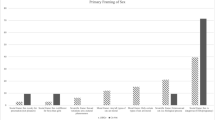Abstract
If discussing sexuality with college students is difficult, discussing sexual orientation often seems impossible. However, given the prejudice and societal violence against lesbians, gays, bisexuals, and transgendered persons, students need to understand the harmful effects of homophobia and heterosexism. This article offers a review of the literature on teaching about sexual identity, nonthreatening strategies for effecting change, and suggestions about fiction and poetry that might be used in the classroom to raise awareness. Secondary sources provide additional techniques and resources.
Similar content being viewed by others
REFERENCES
Barnard, I. (1993). Bibliography for an anti-homophobic pedagogy: A resource for students, teachers, administrators, and activists. Feminist Teacher, 7(3), 50–52.
Belenky, M. F., Clinchy, B. M., Goldberger, N. R., & Tarule, J. M. (1986). Women' ways of knowing: The development of self, voice, and mind. New York: Basic Books, Inc.
Brown, R. M. (1973). Rubyfruit jungle. New York: Bantam.
Buck, C. (1987). “You better not never tell nobody but God. It'd kill your mammy”: Obstacles to talking about sex with our students. Feminist Teacher, 2(3), 31–34.
Cooper, B. (1951/1998). Burls. [from the Los Angeles Time Magazine.] In Literature: Reading fiction, drama, poetry, and the essay (4th ed.) (Robert DiYanni, ed.). Boston: McGraw-Hill, 1876–1882.
Faderman, L. (Ed.). (1994). Chloe plus Olivia: An anthology of lesbian literature from the seventeenth century to the present. New York: Viking.
Fisch, A. (1998). On the discomforts of teaching. Feminist Teacher, l2(1), 40–43.
Gibson, M. and Meem, D (1996). Teaching, typecasting, and butch-femme identity. Feminist Teacher, 10(1), 12–16.
Goodman, E. (1999) A jury' crushing message. The News and Observer. May 13, p. 19A.
Kenan, R. (1989). A visitation of spirits. New York: Anchor Books.
McQuarrie, F. A. E. (1998). Expanding the concept of diversity: Discussing sexual orientation in the management classroom. Journal of Management Education, 22(2), 162–173.
Mickelbury, P. (1995). Night songs. Tallahassee, FL: Naiad Press.
Middlebrook, D. W. (1998). Suits me: The double life of Billy Tipton. Boston, New York: Houghton Mifflin Company.
Morrison, T. (1987). Beloved. New York: Plume.
Myers, P., and Kardia, D. (1997). “But you seem so normal!”: Multidimensional approaches to unlearning homophobia on a college campus. In J. T. Sears & W. L. Williams (Eds.), Overcoming heterosexism and homophobia: Strategies that work. (pp. 197–208). New York: Columbia University Press.
Parker, P. (1991). My lover is a woman. In M. A. Ferguson (Ed.), Images of women in literature (5th ed.) (pp. 383–385). Boston: Houghton Mifflin Company.
Peach, L. J. (Ed.). (1998). Heterosexuality questionnaire. In Women in culture: A women' studies anthology. (pp. 81–82). Malden, MA: Blackwell'.
Piercy. M. (1976). Woman on the edge of time. New York: Fawcett Crest.
Pohan, C. A. and Bailey, N. J. (1998). Including gays in multiculturalism. Education Digest, 63(5), 52–57.
Rakow, L. F. (1992). Gender and race in the classroom: Teaching way out of line. Feminist Teacher, 6(1), 10–13.
Reiss, M. J. (1997). Teaching about homosexuality and heterosexuality. Journal of Moral Education, 26(3), 343–353.
Rosenblum, K. and Travis, T-M. C. (1996). The meaning of difference: American constructions of race, sex, and gender, social class, and sexual orientation. New York: McGraw-Hill
Royster, J. J. (1996). When the first voice you hear is not your own. College Composition and Communication, 47(Feb.), 29–40.
Rule, J. (1981). Middle children. In M. A. Ferguson (Ed.), Images of women in literature (3rd ed.) (pp. 474–479). Boston: Houghton Mifflin Company.
Sears, J. T. and Williams, W. L. (Eds.), (1997). Overcoming heterosexism and homophobia: Strategies that work. New York: Columbia University Press.
Spillane, M. (1948). I, the jury. New York: Signet Books.
Tice, T. N. (1995). Homosexuality. Education Digest, 61(2), 47.
Verrone, T. and Whitman, J. S. (n.d.). Things that make you go hmmm:::: Unpublished manuscript. In J. S. Whitman, Providing training about sexual orientation in counsellor education.
Walker, A. (1982). The color purple. New York: Washington Square Press.
Whitman, J. S. (1995). Providing training about sexual orientation in counsellor education. Counsellor Education & Supervision, 35(2), 168–176.
Wilson, L. (1978). 5th of July. New York: Hill and Wang.
Winterson, J. (1992). Written on the body. New York: Vintage International.
Yescavage, K. and Alexander, J. (1997). The pedagogy of marking: Addressing sexual orientation in the classroom.” Feminist Teacher, 11(1/2), 113–122.
Rights and permissions
About this article
Cite this article
Farr, M.T. “Everything I Didn't Want to Know I Learned in Lit Class”: Sex, Sexual Orientation, and Student Identity. International Journal of Sexuality and Gender Studies 5, 205–213 (2000). https://doi.org/10.1023/A:1010132914278
Issue Date:
DOI: https://doi.org/10.1023/A:1010132914278




